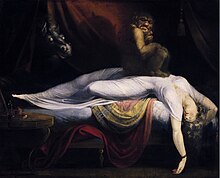Nightmare: Difference between revisions
m robot Removing: ga:Tromluí |
No edit summary |
||
| Line 14: | Line 14: | ||
Fearfulness in waking life is correlated with the incidence of nightmares.<ref name="npr">[http://www.npr.org/templates/story/story.php?storyId=15778923 The Science Behind Dreams and Nightmares], ''Talk of the Nation'', national Public Radio. 30 October 2007.</ref> |
Fearfulness in waking life is correlated with the incidence of nightmares.<ref name="npr">[http://www.npr.org/templates/story/story.php?storyId=15778923 The Science Behind Dreams and Nightmares], ''Talk of the Nation'', national Public Radio. 30 October 2007.</ref> |
||
[[Image:John Henry Fuseli - The Nightmare.JPG|right|thumb|''[[The Nightmare]],'' (1781) ([[Detroit Institute of Art]]). The canvas seems to portray simultaneously a dreaming woman and the content of her nightmare.]] |
|||
==In popular culture== |
==In popular culture== |
||
* Horror film icon [[Freddy Kruger]] is well known for his power to invade the nightmares of children. If he kills the person in the dream, this will in turn actually kill the person. |
* Horror film icon [[Freddy Kruger]] is well known for his power to invade the nightmares of children. If he kills the person in the dream, this will in turn actually kill the person. |
||
==See also== |
==See also== |
||
Revision as of 06:51, 31 March 2010
A nightmare is a dream that can cause a strong negative emotional response from the sleeper, typically fear and/or horror. The dream may contain situation(s) of danger, discomfort, or psychological or physical distress. Sufferers are usually woken in a state of distress, and might be unable to go back to sleep for a prolonged period.
Nightmares can have physical causes such as sleeping in an uncomfortable or awkward position, or having a fever; and psychological causes, such as stress and anxiety. Eating before bed, which triggers an increase in the body's metabolism and brain activity, is a potential stimulus for nightmares.[1]
Occasional nightmares are commonplace, but recurrent nightmares can interfere with sleeping patterns and cause insomnia, and may require medical help. A recently proposed treatment consists of imagery rehearsal.[2] This approach appears to reduce the effects of nightmares and other symptoms in acute stress disorder and post-traumatic stress disorder.[3]
Medical investigation
Studies of dreams have found that about three quarters of dream content or emotions are negative.[4]
One definition of "nightmare" is a dream which causes one to wake up in the middle of the sleep cycle and experience a negative emotion, such as fear. This type of event occurs on average once per month. They are not common in children under 5, but they are more common in young children (25% experiencing a nightmare at least once per week), most common in adolescents, and less common in adults (dropping in frequency about one- third from age 25 to 55).[4]
Fearfulness in waking life is correlated with the incidence of nightmares.[4]

In popular culture
- Horror film icon Freddy Kruger is well known for his power to invade the nightmares of children. If he kills the person in the dream, this will in turn actually kill the person.
See also
- False awakening
- Hag
- Sleep disorder
- Lucid dream
- Mare (folklore)
- Night terror
- Nocnitsa
- Sleep paralysis
- The Nightmare
Notes
- Max Eastman visited Sigmund Freud's apartment in Vienna in 1926. He saw a print of Füssli's The Nightmare next to Rembrandt's The Anatomy Lesson. Ernest Jones chose another version of Füssli's painting as the frontispiece of his book On the Nightmare; however, neither Freud nor Jones mentioned those paintings in their writings about the classic nightmare.
- Recent exhibits: Gothic Nightmares: Füssli, Blake and the Imagination. 15 February – 1 May (2006); Tate Britain, Millbank, London SW1P 4RG.
- When considered a disease, nightmares are classified as follows:
- ICD-10 code = F51.5
- ICD-9 code = 307.47
References
- ^ Stephens, Laura. (2006). "Nightmares". http://web.archive.org/web/20070831193305/http://www.psychologytoday.com/conditions/nightmare.html.
{{cite journal}}: External link in|journal= - ^ Davis JL, Wright DC (2005). "Case series utilizing exposure, relaxation, and rescripting therapy: impact on nightmares, sleep quality, and psychological distress". Behavioral sleep medicine. 3 (3): 151–7. doi:10.1207/s15402010bsm0303_3. PMID 15984916.
- ^ Krakow B, Hollifield M, Johnston L; et al. (2001). "Imagery rehearsal therapy for chronic nightmares in sexual assault survivors with post traumatic stress disorder: a randomized controlled trial". JAMA. 286 (5): 537–45. doi:10.1001/jama.286.5.537. PMID 11476655.
{{cite journal}}: Explicit use of et al. in:|author=(help)CS1 maint: multiple names: authors list (link) - ^ a b c The Science Behind Dreams and Nightmares, Talk of the Nation, national Public Radio. 30 October 2007.
- Anch, A.M., & Browman, C.P., & Mitler, M.M., & Walsh, J.K. (1988). Sleep: A scientific perspective. New Jersey: Prentice-Hall, Inc.
- Harris J.C. (2004). Arch Gen Psychiatry. May;61(5):439-40. The Nightmare. (PMID 15123487)
- Jones, Ernest (1951). On the Nightmare (ISBN 0-87140-912-7) (pbk, 1971; ISBN 0-87140-248-3).
- Forbes, D. et al. (2001) Brief Report: Treatment of Combat-Related Nightmares Using Imagery Rehearsal: A Pilot Study, Journal of Traumatic Stress 14 (2): 433-442
- Siegel, A. (2003) A mini-course for clinicians and trauma workers on posttraumatic nightmares.
- Burns, Sarah (2004). Painting the Dark Side : Art and the Gothic Imagination in Nineteenth-Century America. Ahmanson-Murphy Fine Are Imprint, 332 pp, University of California Press, ISBN 0-520-23821-4.
- Davenport-Hines, Richard (1999). Gothic: Four Hundred Years of Excess, Horror, Evil and Ruin. North Point Press, p160-61.
- Hill, Anne (2009). What To Do When Dreams Go Bad: A Practical Guide to Nightmares. Serpentine Media, 68 pp, ISBN 1-88759-004-8
- Simons, Ronald C and Hughes, Charles C (eds.)(1985). Culture-Bound Syndromes. Springer, 536pp.
- Sagan, Carl (1997). The Demon-Haunted World: Science as a Candle in the Dark.
